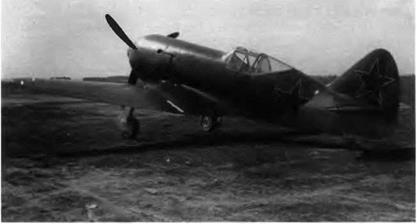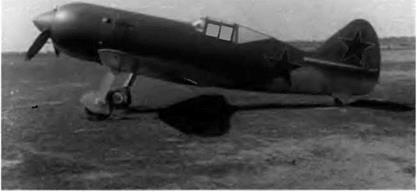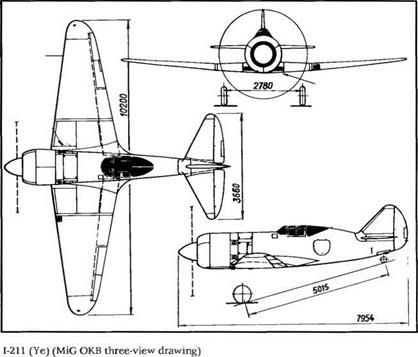1-211 / Ye
As mentioned earlier, this program was a direct result of the 1-210 tests in one of the full-scale TsAGI wind tunnels. The goal was still to prolong the MiG-3 series with an updated product. But to improve the level and climbing speeds of the aircraft, it was necessary to find a more powerful engine than the M-82A and to reduce its takeoff weight significantly. The only available engine alternative was the M-82F, delivering 1,362 kW (1,850 ch) at takeoff and 979 kW (1,330 ch) at
|
|
|
|
The 1-211 marked a new attempt to match a radial engine with the MiG-3 airframe. This time it was a complete success. But, strangely enough, the project was not pursued, and Lavochkin inherited most of the technical innovations tested with this machine.
5,400 m (17,700 feet). The 1-211 differed from the 1-210 in several other respects as well. The front fuselage cross section was increased to make the junction of the engine cowling and the fuselage smoother, and the adjustable flaps of the engine exhaust outlet were moved to the sides of the fuselage. The cockpit was moved 245 mm (9.64 inches) back and the fin chord was extended forward, increasing its area and improving the aircraft’s yaw stability. The oil cooler air inlets were moved into the wing root fairings. The shape of the engine cowling was carefully designed to cope with the problem of airtightness and to achieve the best junction possible with the fuselage. All of these modifications resulted in an outstanding increase in the aircraft’s speed. In 1942 most of these technical innovations (engine cowling design and airtightness, proper positioning of the engine itself, and the 1-210 wing leading edge slats) were passed on—at the order of the Narkomavprom (state commissariat of the aviation industry)—to the Lavochkin OKB, which adapted them successfully to the La-5, a mass-produced fighter.
The armament was also modified: the 1-210’s machine guns were replaced by two synchronized 20-mm ShVAK cannons at the bottom of engine cowling. Assembly of the 1-211 begai in December 1942 and finished in August 1943. Golofastov was the first pilot to fly it. Two prototypes were built, followed by eight preproduction aircraft. The shortcomings of the first 1-210 and its engine became nothing more than a bad memory, and the 1-211 proved to be the best Russian fighter of the time. Compared with the 1942 version of the La-5, its level speed was 40 to 166 km/h (21 to 90 kt) higher, depending on the altitude. Compared with the 1942 version of the Yak-9, it was 65 to 73 km/h (35 to 39 kt) faster. To climb to 5,000 m (16,400 feet), the La-5 took 1.4 to 2.2 minutes longer, and the Yak-9 0.9 to 1.5 minutes longer. After the prototypes passed the factory flight tests, ten preproduction 1-21 Is were delivered to the VVS to prove themselves in combat. They engaged successfully in air battles over the northwestern front near Kalinin. Air force pilots and Nil WS test pilots spoke out in favor of adding the 1-211 to the WS fleet. But in spite of their recommendations and the aircraft’s remarkable flying qualities, the GKO (defense state committee) gave up mass-producing the aircraft because two factories were already building the La-5FN (an La-5 with an ASh-82FN engine)
Specifications
Span, 10.2 m (33 ft 5.6 in); length, 7.954 m (26 ft 1.1 in); height, 3.63 m (11 ft 10.9 in); wheel track, 2.78 m (9 ft 1.4 in); wheel base, 5 015 m (16 ft 5.4 in); wing area, 17.44 m2 (187.7 sq ft); empty weight, 2,528 kg (5,572 lb); takeoff weight, 3,100 kg (6,830 lb); fuel + oil, 385 kg (848 lb); wing loading, 177.75 kg/m2 (36.38 lb/sq ft).
|
|
Performance
Max speed, 670 krn/h at 7,000 m (362 kt at 22,960 ft); climb to 5,000 m (16,400 ft) in 4 min; service ceiling, 11,300 m (37,065 ft); range, 1,140 km (710 mi).













